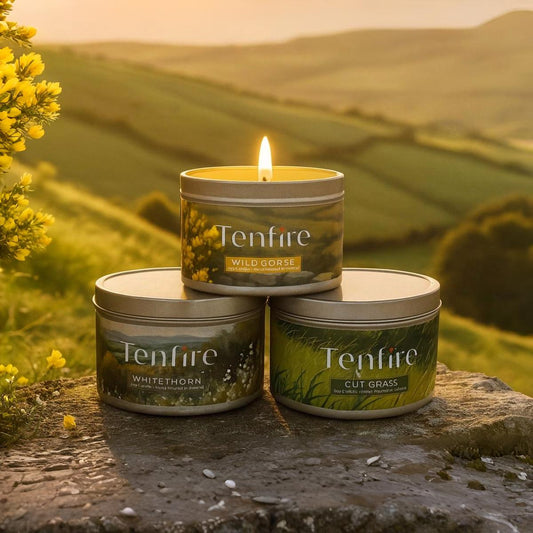
Samhain: The Irish Fire Festival That Still Burns Bright
By Dawn, Founder of Tenfire
Samhain (pronounced "SOW-in") marks the ancient Irish turning of the year. A moment when harvest ended, the veil between worlds thinned, and fires burned to protect and guide. Today, while most of the world celebrates Halloween, Samhain remains a deeply Irish story of fire, memory, and renewal.
TL;DR
- Samhain marks the turning of the Irish year from light to dark.
- Fire and light symbolized connection, protection, and renewal.
- Modern Halloween has deep roots in ancient Irish Samhain rituals.
- Lighting a candle today continues a timeless Irish act of remembrance.
The Origins of Samhain
Long before carved pumpkins and trick-or-treaters, Ireland marked Samhain, the festival that divided the light half of the year from the dark. The name comes from the old Irish word for “summer’s end.” For ancient communities, it was both an ending and a beginning. Crops gathered, animals brought in from the fields, fires extinguished and rekindled to honour the cycle of life and death.
At sites like the Hill of Tara and Tlachtga, enormous fires once blazed, lighting up the Irish landscape and the skies above. Villages would take embers from these sacred flames back to their own hearths, carrying the new year's fire home.
Even then, Ireland understood something profound. That light is a thread through darkness, not a weapon against it.
The Meaning of Fire and Light
Fire at Samhain wasn't just warmth. It was connection between worlds families, and between the living and the dead.
As the veil was said to thin, people would light candles in their windows or fires in their grates to guide loved ones’ spirits home. The scent of turf smoke curling through the air wasn’t only familiar; it was protective, comforting, almost sacred.
That ancient habit endures. In Ireland, many homes still burn turf on the hearth, and that same earthy, smoky aroma inspired our Turf Candle.
Ancient Rituals and Irish Hearths
At Samhain, the everyday became symbolic. Doors were left unlatched so wandering souls could enter. Plates of food were set by the hearth. People disguised themselves in straw or animal skins to confuse mischievous spirits. The first flickers of what would later become costumes and masks.
The hearth was the heart of it all. It glowed through the long night, keeping stories alive while wind and rain swept over the hills. That intimacy, the small circle of light in a dark season, is something we still crave whether it’s a real fire or a flickering candle that stands in for one.

From Samhain to Halloween
When Irish people emigrated to America, they carried these stories with them. Over generations, Samhain's rituals blended with local folklore and became the Halloween celebrated today: pumpkins replacing turnips, ghost tales taking new forms. But beneath the costumes and candy lies the same instinct: to light something bright in the dark, to gather, to remember.
That’s Ireland’s quiet gift to the world, a tradition that turned fear of darkness into something beautiful and communal.
Keeping the Tradition Alive
Lighting a candle on Samhain night isn’t about superstition. It’s a small act of continuity. A reminder that warmth matters more when the year turns cold, and memory burns longer than flame.
Whether you live along the Irish coast or halfway across the world, that spark of connection endures. It lives in scent, in ritual, in every moment you stop to notice the comfort of firelight.
Final Thoughts from Dawn
I’ve always loved that Ireland’s oldest festival isn’t about grand ceremony but about light shared quietly. When I light a Turf Candle, it reminds me of how Irish people have always met darkness with smoke, scent and story.
So if this Samhain finds you far from home, light something, even something small. You’re part of a tradition that’s thousands of years old, still flickering in every Irish heart around the world.
— Dawn





